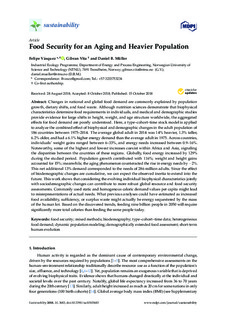| dc.contributor.author | Vasquez, Felipe | |
| dc.contributor.author | Vita, Gibran | |
| dc.contributor.author | Mueller, Daniel Beat | |
| dc.date.accessioned | 2018-10-16T08:51:39Z | |
| dc.date.available | 2018-10-16T08:51:39Z | |
| dc.date.created | 2018-10-15T08:42:40Z | |
| dc.date.issued | 2018 | |
| dc.identifier.citation | Sustainability. 2018, 10 (3683), . | nb_NO |
| dc.identifier.issn | 2071-1050 | |
| dc.identifier.uri | http://hdl.handle.net/11250/2568162 | |
| dc.description.abstract | Changes in national and global food demand are commonly explained by population growth, dietary shifts, and food waste. Although nutrition sciences demonstrate that biophysical characteristics determine food requirements in individuals, and medical and demographic studies provide evidence for large shifts in height, weight, and age structure worldwide, the aggregated effects for food demand are poorly understood. Here, a type–cohort–time stock model is applied to analyze the combined effect of biophysical and demographic changes in the adult population of 186 countries between 1975–2014. The average global adult in 2014 was 14% heavier, 1.3% taller, 6.2% older, and had a 6.1% higher energy demand than the average adult in 1975. Across countries, individuals’ weight gains ranged between 6–33%, and energy needs increased between 0.9–16%. Noteworthy, some of the highest and lowest increases coexist within Africa and Asia, signaling the disparities between the countries of these regions. Globally, food energy increased by 129% during the studied period. Population growth contributed with 116%; weight and height gains accounted for 15%; meanwhile, the aging phenomenon counteracted the rise in energy needs by −2%. This net additional 13% demand corresponded to the needs of 286 million adults. Since the effect of biodemographic changes are cumulative, we can expect the observed inertia to extend into the future. This work shows that considering the evolving individual biophysical characteristics jointly with sociodemographic changes can contribute to more robust global resource and food security assessments. Commonly used static and homogenous caloric demand values per capita might lead to misrepresentations of actual needs. What previous analyses could have estimated as increased food availability, sufficiency, or surplus waste might actually be energy sequestered by the mass of the human lot. Based on the discovered trends, feeding nine billion people in 2050 will require significantly more total calories than feeding the same people today. | nb_NO |
| dc.language.iso | eng | nb_NO |
| dc.publisher | MDPI | nb_NO |
| dc.rights | Navngivelse 4.0 Internasjonal | * |
| dc.rights.uri | http://creativecommons.org/licenses/by/4.0/deed.no | * |
| dc.title | Food security for an ageing and heavier population | nb_NO |
| dc.title.alternative | Food security for an ageing and heavier population | nb_NO |
| dc.type | Journal article | nb_NO |
| dc.type | Peer reviewed | nb_NO |
| dc.description.version | publishedVersion | nb_NO |
| dc.source.pagenumber | 19 | nb_NO |
| dc.source.volume | 10 | nb_NO |
| dc.source.journal | Sustainability | nb_NO |
| dc.source.issue | 3683 | nb_NO |
| dc.identifier.doi | 10.3390/su10103683 | |
| dc.identifier.cristin | 1620283 | |
| dc.description.localcode | © 2018 by the authors. Licensee MDPI, Basel, Switzerland. This article is an open access article distributed under the terms and conditions of the Creative Commons Attribution (CC BY) license (http://creativecommons.org/licenses/by/4.0/). | nb_NO |
| cristin.unitcode | 194,64,25,0 | |
| cristin.unitname | Institutt for energi- og prosessteknikk | |
| cristin.ispublished | true | |
| cristin.fulltext | original | |
| cristin.qualitycode | 1 | |

